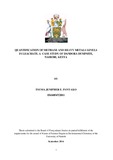| dc.description.abstract | Increased rate of urbanization in Kenya influences solid and liquid waste generation and management and other environmental impacts. This has increased use of landfills to manage wastes and reduce pollution. However, researchers have cited landfills to be one of contributing sources of methane, a greenhouse gas whose level has increased in the atmosphere. It has been noted since 2007 that there is an increase in greenhouse methane attributing to extreme weather and climate change. Methane is a potent environmental pollutant due to its activity as asphyxiate and its explosive nature. Basing on these characteristics and the global concerns about rising levels, the study sought to assess the emission levels of methane from an open landfill at Dandora (dumpsite) in Nairobi County.
Landfills contain leachates which can seep into ground water. Leachate may contain heavy metals that pollute the groundwater supplies. Because of their environmental and health implications, the study also assessed levels of some selected heavy metals i.e. lead, copper, zinc, nickel, chromium and cadmium in the landfill leachate. Sampling was done for six months; during dry, short rain and wet periods. This was mainly to determine the effects of seasons on the levels of analytes. Levels of heavy metals in the leachates were determined using Atomic Absorption Spectrometer (AAS). Gas chromatography with flame ionization detector (FID) was used for methane analysis.
The main aim of this study was to assess levels of methane in landfills and heavy metals in leachate from Dandora dumpsite, in Nairobi Kenya. Leachate was scooped from ten sampling trenches in Dandora dumpsite to analyse level of heavy metals using AAS technique. The findings were that the levels of lead metal ions were highest, 46.49 ppm in November and lowest, 9.58 ppm in April. Levels of copper metal ions were highest, 16.05 ppm in November, 13.2 ppm in February, and lowest, 5.57 ppm in April. Zinc metal ions concentration was highest, 358.4 ppm in November, 340.6 ppm in December, 164.8ppm in
vii
January, 151.9ppm in February, 72.5ppm in March and 46ppm in April. Levels of nickel metal ions ranged from 1.18 ppm in April to 7.92ppm in November. Chromium metal ions levels were between 7.04 ppm in March and 14.27 ppm in November. Cadmium metal ions were found at three sampling points during the month of December only. Their concentration was 0.09 ppm.
Methane was highest at the sampling point where wet waste was disposed. The levels of methane ranged from below detectable level (BDL) at five points to as high as 3779.8717 ppm at point P17. Methane flux ranged from zero to 48869.0515 μg C m-2 h-1 at point P12. The part of dumpsite covered by vegetation, bear dry ground or/and the inactive site had lowest level of methane or no methane was detected | en_US |



